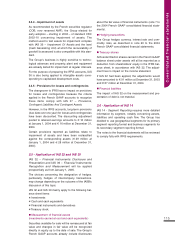APC 2004 Annual Report Download - page 116
Download and view the complete annual report
Please find page 116 of the 2004 APC annual report below. You can navigate through the pages in the report by either clicking on the pages listed below, or by using the keyword search tool below to find specific information within the annual report.
114
Plan assets have been reclassified as a deduction of
corresponding plan liabilities (315 million at January
1, 2004 and 262 million at December 31, 2004).
Net effect on pension and other post employment
benefit liabilities is 420 million at January 1, 2004
and 365 million at December 31, 2004.
The absence of amortization of actuarial gains and
losses recognized in the balance sheet has an effect
of 38 million on the 2004 IFRS income statement.
of which 20 million is reported in administrative
costs and 18 million in cost of sales.
Going forward, the Group has decided to recognize all
actuarial gains and losses in shareholders' equity, on
the line "Statement Of Recognized Income and
Expenses ("SORIES")", as allowed in the amended
version of IAS 19 (not yet endorsed by European
Union). The amount for 2004 is 22 million, net of tax.
2.3.6 - Revenue recognition
The revenue recognition policies applied in the
French GAAP accounts are not materially different
from the requirements of IAS 18 -
Revenue
and IAS
11 -
Long-Term Contracts:
Sales of goods are recognized when the significant
risks and rewards of ownership are transferred to the
buyer.
Long-term contract revenue is recognized by the
percentage-of-completion method and a provision is
booked for expected contract losses as soon as they
are considered probable.
Volume rebates granted to distributors are recog-
nized as an expense from initial sales made by
Schneider Electric to these distributors.The change in
generating event has been recognized under French
and IFRS financial statements as of January 1, 2004
and represents 32 million.
Certain cash discounts (8.4 million in 2004)
included in interest expense and certain sales incen-
tives (7.6 million in 2004) reported under selling
expenses have been reclassified as a reduction of
sales in the IFRS accounts.
2.3.7 - IFRS 2- Share-Based Payments
I
FRS 2 applies to stock options granted after
November 7, 2002 that do not vest prior to January 1,
2005.
The plans concerned are plan 21 dated February 5,
2003 (2,000,000 options exercisable as from
February 5, 2007) and plan 24 dated May 6, 2004
(2,060,700 options exercisable as from May 6, 2008).
The Group has chosen to value options using the Cox
Ross Rubinstein binomial option pricing model.
Based on market data at the grant dates, the total
stock option expense for 2004 is 8.9 million, report-
ed under administrative expenses.
2.4 - Standards with little
or no impact on the Group accounts
2.4.1 - Consolidation scope and methods
Application of the control criteria set out in IAS 27 -
Consolidated Financial Statements And Accounting
For Investments In Subsidiaries
has not led to any
change in the companies fully consolidated in the
Group accounts.
The principles and methods described in Note 1.3 to
the 2004 French GAAP consolidated financial state-
ments are compliant with IFRS.
2.4.2 - Foreign currency translation
The cumulative translation adjustment has been reset
to zero in the opening IFRS balance sheet at January
1, 2004, as allowed under IFRS 1. The impact of
reclassification within shareholder's equity at January
1, 2004 is 211 million.
Adoption of IAS 21 and IAS 29 has no impact on the
Group accounts because the foreign currency con-
version and translation principles applied in the
French GAAP accounts (note 1.4 and 1.5 to the 2004
French GAAP Consolidated Financial Statements)
comply fully with the methods prescribed under IFRS.
2.4.3 - Property, plant and equipment and leases
Adoption of IAS 16 -
Property, Plant And Equipment
and IAS 40 -
Investment Property
has no impact on
the Group accounts.
Property, plant and equipment consist mainly of man-
ufacturing equipment dedicated to specific product
lines and material parts of individual items of equip-
ment are already depreciated separately in the
French GAAP accounts.
Consequently, there is no need to change the assets'
carrying value or depreciation schedules to comply
with IAS 16. In addition, the Group does not own any
investment property.
The Group has chosen to apply the benchmark treat-
ment set out in IAS 16, which consists of measuring
property, plant and equipment in the opening IFRS
balance sheet at historical cost.
Adoption of IAS 17 - Leases has led to the restate-
ment of certain non material leases. The impact is
5.5 million on assets and 5 million on financial
debt as of January 1, 2004.
In accordance with IFRS 5 -
Non-Current Assets Held
For Sale And Discontinued Operations
, assets held
for sale at the year-end (consisting mainly of real
estate) are reported separately for 15 million at
January 1, 2004 and 8 million at December 31,
2004.
In the French GAAP accounts, borrowing costs for the
acquisition of property, plant and equipment are rec-
ognized as an expense and no such costs are capi-
talized. This method corresponds to the benchmark
treatment set out in IAS 23 -
Borrowing Costs.
























